- Top 10 Cat Names - March 4, 2024
- American Bobtail Cat Breed- Profile and Facts - July 8, 2023
- Black Cat Names 2023- With Meanings - June 28, 2023
How long do outdoor cats live? It depends on a number of factors such as the health of the individual cat, the area where she is living in, the availability of food and shelter, and other animals and the human population living in the area. In general outdoor cats live shorter lives between 2 to 5 years.
But when we dig out the root of this question we find that it’s linked to the traditional ‘Indoor vs Outdoor Cats’ debate. In other words, the world has been divided on the topic: should you keep your cat indoors all the time to keep her and other living creatures safe or should you allow her to roam outside freely and enjoy her freedom?
Wildlife conservation activists strongly discourage letting cats outside because they see free cats as a threat to wildlife. Especially for those small creatures which are always in danger of becoming the prey of this fierce predator. Conservationists’ second argument is that cats transfer tonnes of pathogens to other living creatures including humans and cats themselves which often become the cause of serious diseases such as Campylobacter, Cat Scratch Disease (Bartonella henselae), Cat Scratch Disease (Bartonella henselae) and more.
The Centers for Disease Control and Prevention (CDC) has given a list of all the major diseases that can be transmitted through cats and dogs to other living creatures on its official website. Do check it out if it is worth your time.
On the other hand, naturalists strongly favour the freedom of cats. Their view of forcing cats to lie within the four walls of the house is unnatural, cruel and unethical.
So, in this paradoxical situation, it becomes really difficult for a cat parent (like you) to decide whether you should allow your cat to go outside or if is it better to keep her safe inside the house.
In this read, I’ll throw some light on the benefits and drawbacks of allowing cats to live outdoors. In addition, we’ll look at the causes behind the shorter lives of outdoor cats as compared to indoor cats.
The Average Lifespan of an Outdoor Cat
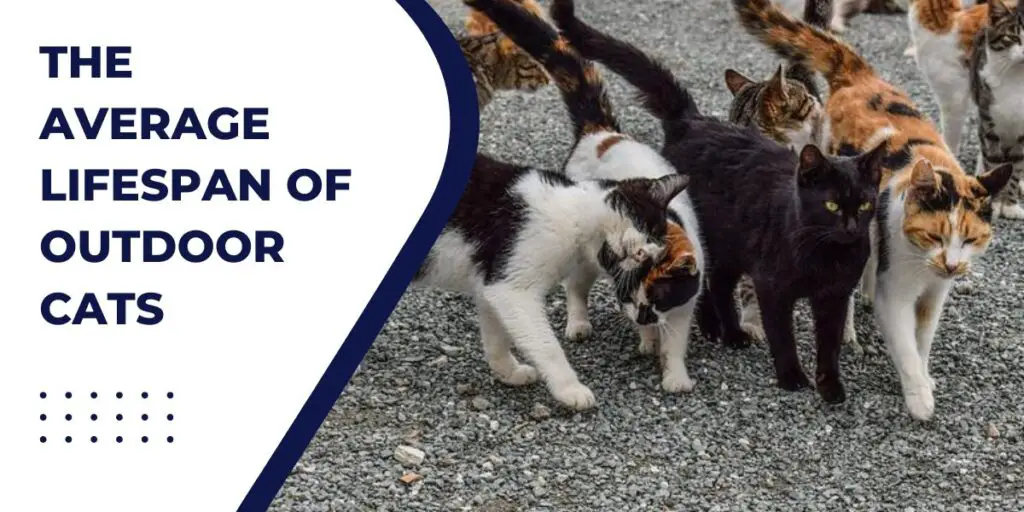
The as said average lifespan of an outdoor cat is very short, just 2 to 5 years. Some cats may live longer and some may live less. But on average, this is what the length of the life of an outdoor cat is.
And even this short life is not full of enjoyment. They have to face lots of challenges, dangers and life-threatening situations every day to survive (we shall discuss them later).
On the other hand, the average lifespan of an indoor cat is 12 to 18 years. Some indoor cats can live up to 20-21 years. Therefore, the lives of outdoor cats are much shorter than indoor cats.
On top of that, indoor cats don’t have to face those challenges and dangers like those who live outdoors. This is one of the major reasons why cat behaviourists, veterinarians and animal organisations in the United States of America advise cat parents to keep their cats indoors.
You May Like to Read: Catify Your Home
Major Causes of the Early Death of Outdoor Cats
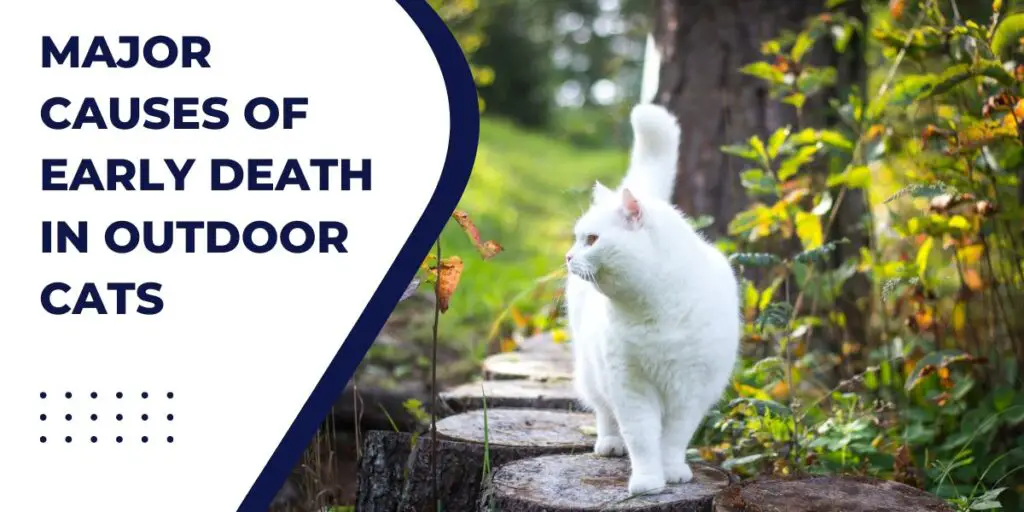
It’s not easy to live on the streets, bushes and on footpaths neither for humans nor for cats. Here’s the list of the major day-to-dangers that outdoor cats have to face which often take away their lives at an early age.
1. Road Accidents
The Streets are not safe at all. With the increase in population, more and more vehicles are coming to the road every passing year.
According to the Culture Change Organisation, about 1 million animals are hit by vehicles on the road only in the U.S.A. these stats are enough to feel how worse the streets have now become for stray and wild animals.
Road accidents are not only dangerous for stray animals but have an equivalent impact on the lives of humans too.
According to a recent report in the Times of India stray animals are the second biggest reason for road accidents in India.
Therefore, road accidents are one of the biggest dangers that cats have to go through in outdoor settings.
2. Attacks by Other Bigger Animals: Like Stray Dogs
The second cause of the early death of outdoor, stray and feral cats is other animals, usually bigger than cats.
Animals like stray dogs, eagles, racoons, skunks, and mongooses can attack and kill cats. They see them as an enemy or easy prey.
So, being a cat owner it’s your responsibility to know about the animals that can attack cats. Especially if you allow your pet cat to go outside so that you can keep her safe.
List of the Animals That Attack Outdoor Cats:
- Stray Dogs
- Eagles
- Coyotes
- Foxes
- Cougars
- Raccoons
- Snakes
- Skunks
- Leopard
- Scorpions
3. Parasites Fleas and Ticks
The third cause of the early death of stray and outdoor cats is parasites. Parasites such as Lungworms, Stomach worms, Bladder worms, and Liver flukes live inside the bodies of cats. They can cause a range of diseases in cats. Some of them even take away their lives. Similarly, ectoparasites(parasites that live on the body of the host) can give rise to serious health issues.
Some of the common diseases that are caused by parasites are:
- Infections
- Abscesses
- Paralysis
- Allergic reactions
- Lyme Disease
Cats who are allowed to go outdoors come in contact with other cats and animals so the chances of getting infected by parasites are much higher in them as compared to their indoor counterparts.
4. Poisoning Due to Drugs and Medicines
The next threat to the lives of outdoor cats is those which are made of drugs and medicines that are made to improve the health of humans.
People just throw the packets and sachets of medicines either on the open grounds, streets or in garbage bins without thinking about their impact on stray animals.
Know that cats can be poisoned by eating many things that are commonly found in human localities such as medications, fertilisers, insecticides and baits.
According to Animal Welfare Victoria, an animal organisation in Australia run by the government, drugs such as Aspirin, Paracetamol, and Human topical pain medication whether eaten either intentionally or unintentionally can create severe health problems in cats. Some of them even kill them.
5. Eating Plants Toxic to Cats
The last threat to outdoor cats is plants that are toxic to cats. In general, cats don’t really feel the drive to go close to plants that can harm them. But sometimes, out of curiosity they might nibble a bit of them.
Poisonous plants can cause a range of health problems in cats including but not limited to vomiting, dizziness and even death.
Some plants that are commonly poisonous to cats are peace lilies, tulips, Iris and aloe vera and more.
The Cat Organisation of the United Kingdom has published a list of plants that are toxic to cats. You may like to check it out.
Benefits of Being an Outdoor Cat
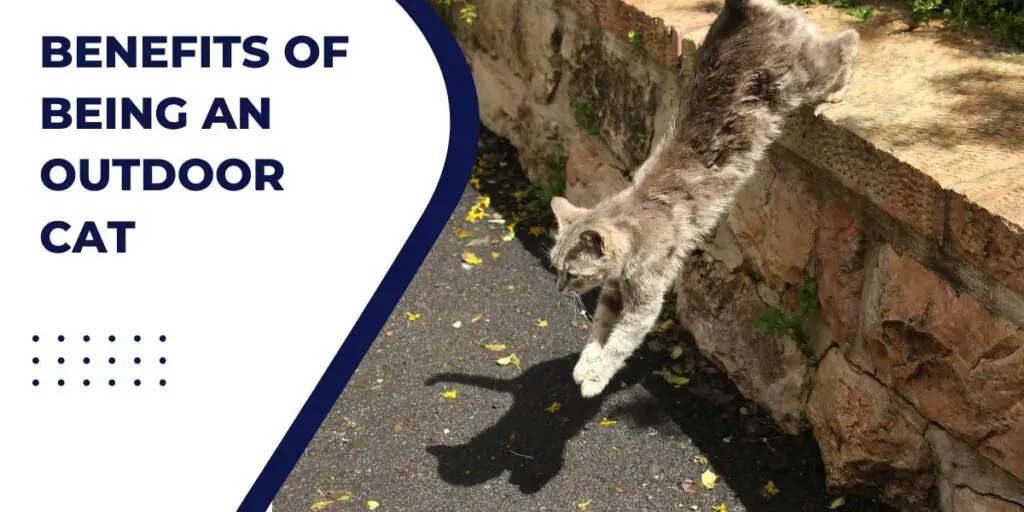
Alright, being an outdoor cat enjoy some luxuries which indoor cats have to compromise for the sake of living longer lives. So let’s now look at the privileges that are available to outdoor cats.
1. Outdoor Cats Enjoy More Freedom Than Indoor Cats
Let’s keep it straight and simple. Outdoor cats have no ‘hooman master’ to order them what to do and what to abstain from. So, undoubtedly they enjoy more freedom than indoors. They can scratch whatever they wish to; roam wherever they want; and eat whatever they like.
Here, I want to highlight the issue that some cat parents are too dominating with their pet cats. They want their cat to live in strict discipline and often get annoyed when their cat does anything which falls out of their ideal model of pet.
And, if you think the same way then here, you need to understand that she is still a cat. You can train her but you can’t change her instincts. And, if she’s doing something wrong then most probably you are ignoring something which is leading to the dissatisfaction of her instinctual desires that need to be addressed if you want her to be a happy cat.
2. Outdoor Cats Have More Opportunities to Play and Exercise Than Indoor Cats
The outdoors is the natural environment of cats where they have been living for thousands of years before we brought them into our homes. The trees, the barns, the bushes, the rocks and the real prey give them tons of opportunities to play, exercise, and hunt. All these activities are immensely important for having healthy bones, muscles and bodies. What’s more important is the happiness which they get by living their natural lives.
Unfortunately, indoor cats can’t live their lives upto to the level of enjoyment that outdoor cats have. Even though you have filled your house with toys, trees, condos and food. This has brought us to the third benefit of being an outdoor cat and that is the satisfaction of instincts.
3. Outdoor Cats Have More Opportunities to Satisfy Their Instincts Than Indoor Cats
I have told you before, and I’m telling you again. Cats follow a pattern of behaviour. Hunt catch, catch, kill, eat and rest. This is what cats do in their day. This is what they have been doing throughout the centuries.
Outdoor cats, whether they are indoor-outdoor pet cats or stray or feral cats have a lot more opportunities to satisfy their instincts than their indoor counterparts. Because they live behind the walls, indoor cats get fewer opportunities to satisfy their instinct. This is where the concept of cat toys and trees originated from. Because if your cat’s instincts would not meet she may turn into an unsatisfied, bored, and unhealthy cat both mentally and physically.
Drawbacks of Letting Your Cats Go Outdoors
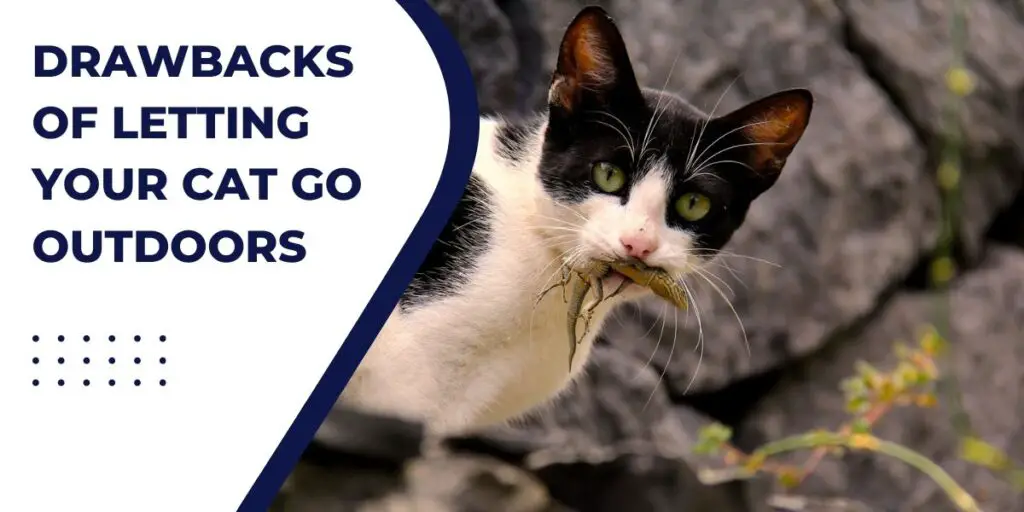
After summing up the benefits that outdoor cats enjoy now let’s count the drawbacks that compel us to keep the cat indoors.
1. Injuries and Death in Accidents
As we have discussed above thousands of outdoor cats die in accidents every year. Indoor cats do not have to face the danger of hitting by a vehicle while crossing a road or pathway.
2. Lack of Food, Poor Nutrition and Starvation
Outdoor cats, especially those who live in close proximity to human settlements often have to struggle for food. You must have seen stray cats exploring the garbage bin or eating stale food or something which is not good for their health. They don’t get proper nutrition. Many of them die out of starvation too.
3. Killing WildLife
Cats who have access to the outdoors are a threat to small wildlife. Cats usually try to attack and kill, rats, rabbits, lizards, chickens and small birds. It’s sad but true that free-roaming cats kill millions of small creatures every year.
4. The Danger of Getting Preyed On
Free-roaming cats do not always kill. Bigger and more dangerous animals like dogs, skunks, eagles, mongooses, leopards, and cougars see cats as easy targets and kill them whenever they get the opportunity.
5. The Risk of Getting Lost
The next risk of letting your cats go outdoors is losing her forever. If you are a member of cat groups on social media you often come across posts where people ask for help in finding their cats.
3. The Risk of Catching and Tranmisttiing the Diseases
There is a long list of diseases that cats transmit to cats, other animals and humans. The chances of catching a disease and transmitting are higher in cats who have access to the outdoors.
Indoor vs Outdoor Cats
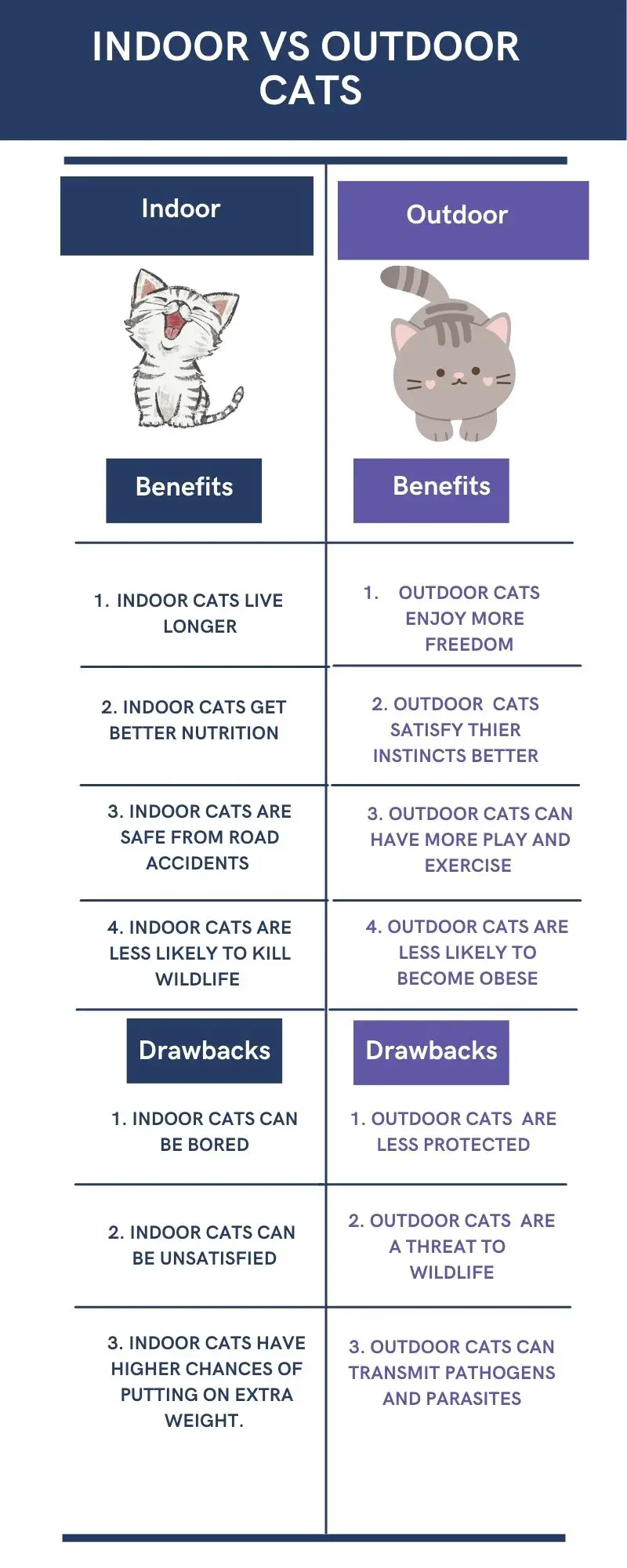
Do Outdoor Cats Have Shorter Lives?
Yes, outdoor cats have a much shorter life than indoor cats because they have to live in more challenging situations than their indoor counterparts. The average age of an outdoor cat is just 2 to 5 years while indoor cats can live as long as 15-20 years.
Why do outdoor cats have a short life span?
Outdoor cats are exposed to dangers such as road traffics, attacks by other animals, parasites, pathogens, extreme weather, insecticides, pesticides, drugs and fertilizers. In addition, they may also have to starve at times due to a lack of food. All these factors make their lifespan shorter.
The Bottom Line
How long an outdoor cat life depends on the outdoor conditions in which the particular cat is living. Should you keep your cat only indoors? Well, yes, cats and other small creatures are safer when she remains indoors. However, you must make provisions to keep her engaged, entertained and happy in indoor settings. to achieve this you need to provide her with litter boxes, toys, trees, beds, and vertical spaces. You can also build a personalised cat garden for her if you have a backyard. With that said, I hope you enjoyed reading the article. Thanks for reading. Please share.
